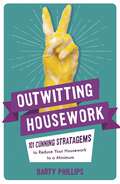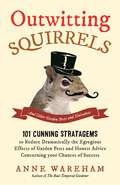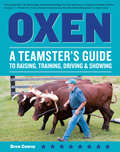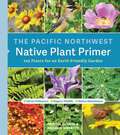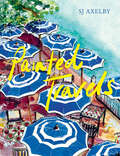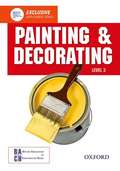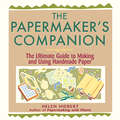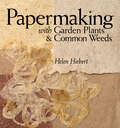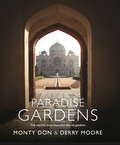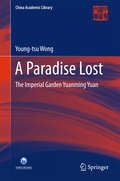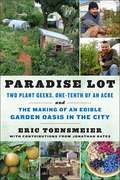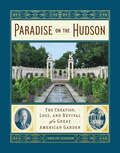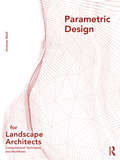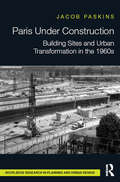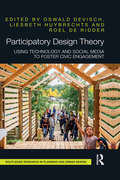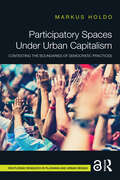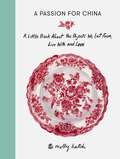- Table View
- List View
Outwitting Housework: 101 Cunning Stratagems to Reduce Your Housework to a Minimum
by Barty PhillipsEntertaining and packed full of time-saving tips, Outwitting Housework is an essential guide to making your house gleam without breaking a sweat. Household expert Barty Phillips shares her clever tips for avoiding chores wherever possible, revealing her sanity-saving shortcuts and creative advice for keeping those boring tasks to a minimum.Discover what basic tools of the trade you need and how to use them to bring sparkle, shine and a sense of calm to your home. Learn how to do effective minimal tidying, train errant family members and engage technology to help save you even more effort. Armed with these cunning and creative stratagems, you’ll soon be drying off those rubber gloves and doing something much more fun instead.
Outwitting Squirrels: And Other Garden Pests and Nuisances
by Anne WarehamAn entertaining and practical collection of tips and tricks to outsmart all kinds of garden pests, written by one of Britain’s most influential gardeners.If you have ever waged war against squirrels to prevent them from ransacking your garden, you will know that they are wily beasts, who can find loopholes in the most cunning of defences. In this comprehensive guide, Anne Wareham recommends a host of ingenious anti-pest stratagems to protect your garden from a range of foes.Includes:* advice on dealing with all kinds of creatures, from rabbits, deer, snails and slugs to mites, beetles and bacteria – as well as weeds, the weather, people and much more* Advice is also offered on how to resist fatuous horticultural trends and ignore so-called experts.* Admitting that some pests can't be beaten, the book also advises when you should grow a different plant rather than prolonging the fight.* Author Anne Wareham is a well-known gardening expert and has been described by the Telegraph as one of Britain’s most influential gardeners.Entertaining and practical, this is an honest book of advice that will be appreciated and enjoyed by amateur and professional gardeners alike.
Overcoming Chronic Disorganization: Finding Strategies That Work
by Jo CookeAre you always late, do you miss appointments, lose your keys, forget your phone, miss deadlines at work on projects, have to pay penalties on late returns for paying tax?We can all be impacted by chronic disorganization - whether it be because of long term stress, menopause, diagnoses of ADHD and/or autism (to name just a few of the very many reasons). It has nothing to do with being stupid or lazy. Some brains are wired differently, and understanding this is the way forward to allow us to delegate, find strategies and systems in place to manage our day to day lives - whether in our personal or professional lives. Overcoming Chronic Disorganization will help you recognize your behaviours and put systems in place to help day-to-day tasks seem less overwhelming and challenging. It looks at the triggers and symptoms of CD, at the role of ADHD and/or autism, and at their impact on executive function. From this background of better understanding, you will discover strategies for organizing and decluttering, advice on dealing with things like procrastination, and how to develop healthy habits and keep them going. Whether for you or for a loved one, this book is full of actionable points and wise, compassionate support and is the first step on your journey to a calmer and more organized life.
Oxen: A Teamster's Guide to Raising, Training, Driving & Showing
by Drew ConroyVersatile as well as powerful, oxen can plow fields, haul stones, assist in logging, and improve roads. This comprehensive guide covers all aspects of selecting, training, feeding, and caring for your oxen. You&’ll learn how to fit yokes and bows, address common challenges, and maintain your team&’s overall health. Whether you&’re looking for an economical alternative to heavy machinery on the farm or want to compete at the next county fair, Drew Conroy will help you achieve success with your oxen.
The Pacific Northwest Native Plant Primer: 225 Plants for an Earth-Friendly Garden
by Kristin Currin Andrew MerrittNative plants bring your garden to life—and life to your garden! Here are the best choices for Oregon and Washington. The benefits of native plants are enormous—they reduce maintenance, require less water, and attract vital, earth-friendly pollinators like birds, butterflies, and bees. Gardeners seeking to add them to their landscape will find no better guide than The Pacific Northwest Native Plant Primer. Packed with proven advice that everyhome gardener can follow, this incomparable sourcebook profiles 225 recommended native wildflowers, grasses and grasslike plants, ferns, shrubs, and trees. With additional introductory information on preparation, planting, maintenance, and climate considerations, it&’s everything you need to know to create a beautiful and beneficial garden. This must-have handbook is for gardeners in Oregon, Washington, and southern British Columbia.
Painted Travels: Portraits Of Remarkable Places
by SJ AxelbyAn armchair discovery tour of truly remarkable places, captured in SJ Axelby’s inimitable watercolours. This follow-up volume to SJ Axelby’s Interior Portraits transports the reader to bars, cafes, museums, shops, hotels, tearooms, restaurants, lobbies, vineyards, trains, casinos, members’ clubs and more, around the world.
Painting and Decorating Level 2 Diploma: Student Book (PDF)
by British Association of Construction HeadsWritten for the Cskills Awards Level 2 Diploma in Painting and Decorating, this book has been developed in partnership with the British Association of Construction Heads (BACH) to bring you up-to-date and expert knowledge of painting and decorating.
Painting and Decorating Level 3 Diploma Student Book
by British Association of Construction HeadsThis book has been developed in partnership with the British Association of Construction Heads (BACH) to bring you up-to-date and expert knowledge of painting and decorating. Written for the Cskills Awards Level 3 Diploma in Painting and Decorating, it is also suitable for the equivalent C&G specification.
Painting and Decorating Level 3 Diploma Student Book 1 (PDF)
by British Association of Construction HeadsThis text has been developed in partnership with the British Association of Construction Heads (BACH) to bring you up-to-date and expert knowledge of painting and decorating. Written for the Cskills Awards level 3 diploma in painting and decorating, it is also suitable for the equivalent C & G specification.
The Papermaker's Companion: The Ultimate Guide to Making and Using Handmade Paper
by Helen HiebertCraft your own colorful paper goods and personalized stationary. With clear, step-by-step instructions, Helen Heibert covers all aspects of the papermaking process — from growing and harvesting plants for a malleable paper pulp to embellishment techniques like dyeing, embossing, and laminating. With tips on building your own papermaking equipment, ideas for transforming junk mail into dazzlingly unique notecards, and much more, you&’ll be inspired to let your creativity shine as you explore the endless possibilities of handcrafted papers.
Papermaking with Garden Plants & Common Weeds
by Helen HiebertMake exquisite papers right in your own kitchen. With a few pieces of basic equipment and a small harvest of backyard weeds, you can easily create stunningly original handcrafted papers. Helen Heibert&’s illustrated step-by-step instructions show you how easy it is to blend and shape a variety of organic fibers into professional stationery, specialty books, and personalized gifts. You&’ll soon be creatively integrating plant stalks, bark, flower petals, pine needles, and more to add unique colors and textures to your paper creations. This publication conforms to the EPUB Accessibility specification at WCAG 2.0 Level AA.
Paradise Gardens: the world's most beautiful Islamic gardens
by Monty Don Derry Moore'Lavish ... a celebration of the history and enduring romance of Islamic gardens' Washington PostAs seen on the highly acclaimed BBC2 series Monty Don's Paradise Gardens, a full colour exploration of the astonishing beauty of twenty-nine Islamic paradise gardens from Iran, Turkey, India, England, Spain and Morocco. In the Islamic tradition, a garden with its central elements of water, the scent of fruit trees, and places for rest and reflection, celebrate heaven on earth. Paradise gardens play a central role in everyday life in the Islamic world, yet little is known about them. Monty Don and acclaimed photographer, Derry Moore, set off on a journey to find out more about the principles and immersive delights of paradise gardens and how a very different culture and climate has influenced garden design round the world. Their journey covers twenty-nine gardens from the Real Alcazar and the Alhambra in Spain, and Le Jardin Majorelle in Morocco, to Highgrove and a Mughal garden in Bradford in England. There are some spectacular and rarely seen examples such as Pasargadae and the Maidan in Isfahan, Iran, the birthplace of paradise gardens, as well as the more renowned examples such as Turkey's Topkapi Palace and the Amber Palace and Taj Mahal in India.A glorious celebration of the richness of Islamic culture through some of the most beautiful gardens on earth.'A garden, green and filled with water is heaven on earth - it is paradise.' Monty Don
A Paradise Lost: The Imperial Garden Yuanming Yuan (China Academic Library)
by Young-tsu WongThis book is aimed at readers and researchers who are interested in Chinese garden architecture, the rise and fall of Yuanming Yuan and the history of the Qing dynasty. It is the first comprehensive study of the palatial garden complex in a Western language, and is amply illustrated with photographs and original drawings. Young-tsu Wong’s engaging writing style brings "the garden of perfect brightness" to life as he leads readers on a grand tour of its architecture and history.
Paradise Lot: Two Plant Geeks, One-Tenth of an Acre, and the Making of an Edible Garden Oasis in the City
by Eric Toensmeier Jonathan BatesWhen Eric Toensmeier and Jonathan Bates moved into a duplex in a run-down part of Holyoke, Massachusetts, the tenth-of-an-acre lot was barren ground and bad soil, peppered with broken pieces of concrete, asphalt, and brick. The two friends got to work designing what would become not just another urban farm, but a "permaculture paradise" replete with perennial broccoli, paw paws, bananas, and moringa—all told, more than two hundred low-maintenance edible plants in an innovative food forest on a small city lot. The garden—intended to function like a natural ecosystem with the plants themselves providing most of the garden's needs for fertility, pest control, and weed suppression—also features an edible water garden, a year-round unheated greenhouse, tropical crops, urban poultry, and even silkworms. In telling the story of Paradise Lot, Toensmeier explains the principles and practices of permaculture, the choice of exotic and unusual food plants, the techniques of design and cultivation, and, of course, the adventures, mistakes, and do-overs in the process. Packed full of detailed, useful information about designing a highly productive permaculture garden, Paradise Lot is also a funny and charming story of two single guys, both plant nerds, with a wild plan: to realize the garden of their dreams and meet women to share it with. Amazingly, on both counts, they succeed.
Paradise on the Hudson: The Creation, Loss, and Revival of a Great American Garden
by Caroline SeebohmThis lushly illustrated book tells the amazing story of the rise, fall, and rebirth the Untermyer Garden, one of the most extravagant and celebrated 20th Century gardens.
Parametric Design for Landscape Architects: Computational Techniques and Workflows
by Andrew MadlParametric Design for Landscape Architects provides a sequence of tutorial-based workflows for the creation and utilization of algorithmic tools calibrated toward the field of landscape architecture. Contemporary practice and projective theory in landscape architecture require the processing and design of data associated with complex systems to adequately represent composite, emergent scenarios. Aligning to both traditional and nascent processes of analysis and digital modeling, this book unpacks and decodes the characterization of algorithmic-based automation, leveraging software that is widely accessible in both academia and professional practice. Curated throughout are workflows that apply to a multiplex of computation programs that widely support the design, analysis, and production of landscapes, primarily concentrated on digital modeling tools Grasshopper and Rhinoceros. It is a much-needed, visually accessible resource to aid in more efficient understanding and creation of tools that automate and re-examine traditional calculations, analyses, drawing standards, form-finding strategies, fabrication preparations, and speculative assessments/simulation. This primer provides professionals and students with multifaceted skill-sets that, when applied in practice, expand and expedite conventional and speculative design workflows applicable to spatial design, and more specifically landscape architecture. The book includes over 200 full-colour drawings, images, and tables to illustrate and support examples throughout.
Parametric Design for Landscape Architects: Computational Techniques and Workflows
by Andrew MadlParametric Design for Landscape Architects provides a sequence of tutorial-based workflows for the creation and utilization of algorithmic tools calibrated toward the field of landscape architecture. Contemporary practice and projective theory in landscape architecture require the processing and design of data associated with complex systems to adequately represent composite, emergent scenarios. Aligning to both traditional and nascent processes of analysis and digital modeling, this book unpacks and decodes the characterization of algorithmic-based automation, leveraging software that is widely accessible in both academia and professional practice. Curated throughout are workflows that apply to a multiplex of computation programs that widely support the design, analysis, and production of landscapes, primarily concentrated on digital modeling tools Grasshopper and Rhinoceros. It is a much-needed, visually accessible resource to aid in more efficient understanding and creation of tools that automate and re-examine traditional calculations, analyses, drawing standards, form-finding strategies, fabrication preparations, and speculative assessments/simulation. This primer provides professionals and students with multifaceted skill-sets that, when applied in practice, expand and expedite conventional and speculative design workflows applicable to spatial design, and more specifically landscape architecture. The book includes over 200 full-colour drawings, images, and tables to illustrate and support examples throughout.
Parent Hacks: 134 Genius Shortcuts for Life with Kids
by Asha DornfestLife with kids just got easier with these 134 ingenious hacks developed by parents just like you. Put the ketchup under the hot dog, minimizing the mess. Strap baby into a forward-facing carrier when you need to trim her fingernails—it frees your hands while controlling the squirming. Or stash a wallet in a disposable diaper at the beach—who would ever poke through what looks like a used Pamper? All these hacks are easy to do, are boldly illustrated, and use everyday items in unexpected ways. And the range—from pregnancy and postpartum, through sleep, eating, bath time, travel, and more—covers all the most critical years when parents really need a little extra help. &“Just . . . genius.&”—Buzzfeed
Paris Under Construction: Building Sites and Urban Transformation in the 1960s
by Jacob PaskinsDuring the 1960s, building sites in Paris became spaces that expressed preoccupations about urban transformation, labour immigration and national identity. As new buildings and infrastructure changed the city, building sites revealed the substandard living and working conditions of migrant construction workers in France. Moreover, construction was the touchstone in debates about the dangers of urban life, and triggered action in communities whose districts faced demolition. Paris Under Construction explores the social, political and cultural responses to construction work and urban transformation in the Paris metropolitan region during the 1960s. This examination of a decade of intensive building work considers the ways in which the experience of construction was mediated, produced and reproduced through a range of complex and sometimes contradictory representations. The building sites that produced the new Paris are no longer visible, and were perhaps never intended to be seen, yet different groups closely observed and recorded construction, giving it meanings that went beyond specific building activities. The research draws extensively on French newspaper, television and radio archives, and delves into rarely examined trade union material. Paris Under Construction gives voice to the witnesses of—and participants in—urban transformation who are usually excluded from architectural and urban history.
Paris Under Construction: Building Sites and Urban Transformation in the 1960s
by Jacob PaskinsDuring the 1960s, building sites in Paris became spaces that expressed preoccupations about urban transformation, labour immigration and national identity. As new buildings and infrastructure changed the city, building sites revealed the substandard living and working conditions of migrant construction workers in France. Moreover, construction was the touchstone in debates about the dangers of urban life, and triggered action in communities whose districts faced demolition. Paris Under Construction explores the social, political and cultural responses to construction work and urban transformation in the Paris metropolitan region during the 1960s. This examination of a decade of intensive building work considers the ways in which the experience of construction was mediated, produced and reproduced through a range of complex and sometimes contradictory representations. The building sites that produced the new Paris are no longer visible, and were perhaps never intended to be seen, yet different groups closely observed and recorded construction, giving it meanings that went beyond specific building activities. The research draws extensively on French newspaper, television and radio archives, and delves into rarely examined trade union material. Paris Under Construction gives voice to the witnesses of—and participants in—urban transformation who are usually excluded from architectural and urban history.
Participatory Design Theory: Using Technology and Social Media to Foster Civic Engagement
by Oswald Devisch Liesbeth Huybrechts Roel De RidderIn recent years, many countries all over Europe have witnessed a demand for a more direct form of democracy, ranging from improved clarity of information to being directly involved in decision-making procedures. Increasingly, governments are putting citizen participation at the centre of their policy objectives, striving for more transparency, to engage and empower local individuals and communities to collaborate on public projects and to encourage self-organization. This book explores the role of participatory design in keeping these participatory processes public. It addresses four specific lines of enquiry: how can the use and/or development of technologies and social media help to diversify, to coproduce, to interrupt and to document democratic design experiments? Aimed at researchers and academics in the fields of urban planning and participatory design, this book includes contributions from a range of experts across Europe including the UK, Belgium, the Netherlands, Italy, Denmark, Austria, Spain, France, Romania, Hungary and Finland.
Participatory Design Theory: Using Technology and Social Media to Foster Civic Engagement
by Oswald Devisch Liesbeth Huybrechts Roel De RidderIn recent years, many countries all over Europe have witnessed a demand for a more direct form of democracy, ranging from improved clarity of information to being directly involved in decision-making procedures. Increasingly, governments are putting citizen participation at the centre of their policy objectives, striving for more transparency, to engage and empower local individuals and communities to collaborate on public projects and to encourage self-organization. This book explores the role of participatory design in keeping these participatory processes public. It addresses four specific lines of enquiry: how can the use and/or development of technologies and social media help to diversify, to coproduce, to interrupt and to document democratic design experiments? Aimed at researchers and academics in the fields of urban planning and participatory design, this book includes contributions from a range of experts across Europe including the UK, Belgium, the Netherlands, Italy, Denmark, Austria, Spain, France, Romania, Hungary and Finland.
Participatory Spaces Under Urban Capitalism: Contesting the Boundaries of Democratic Practices (Routledge Research In Planning And Urban Design Ser.)
by Markus HoldoCan people use new participatory spaces to reclaim their rights as citizens and challenge structures of political power? This book carefully examines the constraints and possibilities for participatory governance under capitalism. To understand what is at stake in the politics of participation, we need to look beyond the values commonly associated with it. Citizens face a dilemma: should they participate, even if this helps to sustain an unjust system, or not participate, thereby turning down rare opportunities to make a difference? By examining the rationale behind democratic innovation and the reasons people have for getting involved, this book provides a theory of how citizens can use new democratic spaces to challenge political boundaries. Connecting numerous international case studies and presenting original research from Rosario, Argentina, this book offers a crucial corrective to previous research. What matters most is not the design of new models of participation nor is it the supposed radical imagination of political leaders. It is whether people use new spaces for participation to renegotiate what democracy means in practice. Bridging critical urban studies and democratic theory, this book will be of interest to researchers and students in the fields of democratic innovations, political economy and urban planning. It will also provide activists and practitioners of participatory democracy with important tools to expand spaces of grassroots democracy.
Participatory Spaces Under Urban Capitalism: Contesting the Boundaries of Democratic Practices (Routledge Research In Planning And Urban Design Ser.)
by Markus HoldoCan people use new participatory spaces to reclaim their rights as citizens and challenge structures of political power? This book carefully examines the constraints and possibilities for participatory governance under capitalism. To understand what is at stake in the politics of participation, we need to look beyond the values commonly associated with it. Citizens face a dilemma: should they participate, even if this helps to sustain an unjust system, or not participate, thereby turning down rare opportunities to make a difference? By examining the rationale behind democratic innovation and the reasons people have for getting involved, this book provides a theory of how citizens can use new democratic spaces to challenge political boundaries. Connecting numerous international case studies and presenting original research from Rosario, Argentina, this book offers a crucial corrective to previous research. What matters most is not the design of new models of participation nor is it the supposed radical imagination of political leaders. It is whether people use new spaces for participation to renegotiate what democracy means in practice. Bridging critical urban studies and democratic theory, this book will be of interest to researchers and students in the fields of democratic innovations, political economy and urban planning. It will also provide activists and practitioners of participatory democracy with important tools to expand spaces of grassroots democracy.
A Passion for China: A Little Book About the Objects We Eat from, Live with and Love
by Molly HatchA Passion for China is a personal celebration of the everyday beauty of tableware.'As we move through our daily lives, eating breakfast, sipping an afternoon cup of tea or gathering for a family dinner, the patterned ceramic objects we live with are precious witnesses to our stories. We eat from them, they warm our hands after a cold walk outdoors and we pull them out to celebrate the births, marriages and lives of our loved ones.'Acclaimed ceramicist, artist and designer Molly Hatch explores the family stories behind beloved items - the bowls and cups we have inherited or chosen with love and care - and brings the history of porcelain, potteries and patterns to life through her stunning, hand-drawn illustrations.A tribute to the rich heritage of the vintage plates, jugs and pots that make our homes our own.Please note this is a fixed-format ebook with colour images and may not be well-suited for older e-readers.
